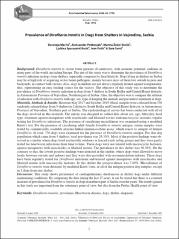Prevalence of Dirofilaria immitis in Dogs from Shelters in Vojvodina, Serbia

View/
Date
2020Author
Marčić, Doroteja
Potkonjak, Aleksandar
Žekić-Stošić, Marina
Spasojević Kosić, Ljubica
Pušić, Ivan
Savić, Sara
Metadata
Show full item recordAbstract
Background: Dirofilaria immitis is vector borne parasite of carnivores, with zoonotic potential, endemic in
many parts of the world, including Europe. The aim of this study was to determine the prevalence of Dirofilaria
immitis infection in dogs from shelters, especially compared to their lifestyle. Dogs living in shelters in Serbia
may be at high risk of acquiring vector borne pathogens, mainly because most of them live outside in pens and
backyards, in contact with vectors. Also, dogs in shelters are not always regularly treated against ectoparasites,
thus, representing an easy feeding source for the vectors. The objective of this study was to determine the
prevalence of Dirofilaria immitis infection in dogs from 5 shelters in South Bačka and Central Banat districts,
in Autonomous Province of Vojvodina, Northern part of Serbia. Also, the objective was to compare the relation
of infection with Dirofiaria immitis with age, sex, type of keeping the animals and preventive treatment in dogs.
Materials, Methods & Results: Between May 2017 and October 2019, blood samples were collected from 336
randomly selected dogs from 5 shelters in 2 districts, South Bačka and Central Banat districts, in Autonomous
Province of Vojvodina, Northern part of Serbia. The epidemiological survey has been conducted with all of
the dogs involved in this research. The survey was designed to collect data about sex, age, lifestyles, food
type, treatment against mosquitoes with insecticides and filarioid worms with macrocyclic lactones, regular
testing for Dirofilaria infections. The presence of circulating microfilariae was examined using a modified
Knott’s test. For the presence of circulating adult female Dirofilaria immitis antigen, serum samples were
tested by commercially available enzyme-linked immunosorbent assay, which reacts to antigen of female
Dirofilaria. In total, 336 dogs were examined for the presence of Dirofilaria immitis antigen. For that dog
population which came from 5 shelters, total prevalence was 25.30%. Most of the positive findings were observed
in a shelter where dogs lived exclusively outdoors in fenced yards in big groups and they were partly
tested for heartworm infections from time to time. These dogs were not treated with macrocyclic lactones,
against mosquitoes with insecticides or filarioid worms. The prevalence in this shelter was 56.36%. On the
contrary to that, the lowest positive findings were detected in the shelter, where dogs were allowed to move
freely between outside and indoors and they were also provided with accommodation indoors. These dogs
have been regularly tested for Dirofilaria infections and treated against mosquitoes with insecticides and
filarioid worms with macrocyclic lactones. In this shelter the seroprevalence was 7.69%. Microfilariae of
Dirofilaria immitis were detected, by modified Knott’s test, in all of the antigen positive dog samples; except
in 2 dogs from one shelter.
Discussion: This study shows persistence of cardiopulmonary dirofiariosis in shelter dogs under different
maintaining conditions. By comparing the data during the last 17 years, it can be stated that there is a constant
increase of prevalence for Dirofilaria immitis in dogs in northern part of Serbia over the years. The results gained
in this study are important from the veterinary point of view, but also from the Public Health point of view.
